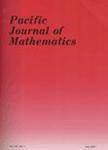版权所有:内蒙古大学图书馆 技术提供:维普资讯• 智图
内蒙古自治区呼和浩特市赛罕区大学西街235号 邮编: 010021

作者机构:Univ Texas Austin TX 78712 USA
出 版 物:《PACIFIC JOURNAL OF MATHEMATICS》 (Pac. J. Math.)
年 卷 期:1999年第189卷第2期
页 面:311-338页
核心收录:
学科分类:07[理学] 0701[理学-数学] 070101[理学-基础数学]
基 金:Directorate for Mathematical and Physical Sciences MPS (9500874)
主 题:.weakly compact exivity basic sequence triangular arrays classes of operators WIDE SEQUENCES non-strongly Tauberian
摘 要:A basic sequence in a Banach space is called wide-(s) if it is bounded and dominates the summing basis. (Wide-(s) sequences were originally introduced by I. Singer, who termed them P*-sequences.) These sequences and their quantified versions, termed lambda-wide-(s) sequences, are used to characterize various classes of operators between Banach spaces, such as the weakly compact, Tauberian, and super-Tauberian operators, as well as a new intermediate class introduced here, the strongly Tauberian operators. This is a nonlocalizable class which nevertheless forms an open semigroup and is closed under natural operations such as taking double adjoints. It is proved for example that an operator is non-weakly compact iff for every epsilon 0, it maps some (1 + epsilon)-wide-(s)-sequence to a wide-(s) sequence. This yields the quantitative triangular arrays result characterizing reflexivity, due to R.C. James. It is shown that an operator is non-Tauberian (resp. non-strongly Tauberian) iff for every epsilon 0, it maps some (1 + epsilon)-wide-(s) sequence into a norm-convergent sequence (resp. a sequence whose image has diameter less than epsilon). This is applied to obtain a direct finite characterization of super-Tauberian operators, as well as the following characterization, which strengthens a recent result of M. Gonzalez and A. Martinez-Abejon: An operator is non-super-Tauberian iff there are for every epsilon 0, finite (1 + epsilon)-wide-(s) sequences of arbitrary length whose images have norm at most epsilon.